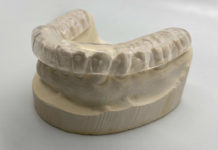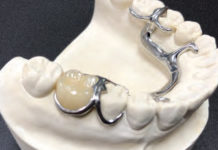
A Discussion with Dr. Brian Britton about a Systematic Approach to Removables.
Aesthetic Dentistry recently spoke with comprehensive dentist Dr. Brian Britton, from Arlington, TX, about making removables a simpler and more profitable process. Dr. Britton will teach a simplified system to other dentists during an upcoming new course with the Dr. Dick Barnes Group (DDBG). Here’s a brief synopsis of that conversation:
AD: WHERE DID THE IDEA OF SIMPLIFYING THE PROCESS OF REMOVABLES ORIGINATE?
Dr. Britton: Arrowhead Dental Laboratory approached me about developing a simplified course after noticing a need among dentists. Arrowhead had received numerous calls from doctors asking about a way to make the removables process easier. The result was a four-step system that any dentist can use.
Dentures can be somewhat difficult, and many dentists don’t like doing them because it’s essentially just putting a piece of plastic in somebody’s mouth. Getting them right can be difficult and exacting.
Many doctors consider removable prosthetics an old-school way of doing things. And because doctors often have to readjust dentures over several appointments, profitability is often not very high. But if a patient can’t afford to have a fixed hybrid denture, removables are a great alternative.
In addition to being a great skill, learning to place dentures can be a stepping stone to other advanced treatments, like implants. Dentists need to have a basic knowledge of how to do traditional removable dentures. They should understand dentures and denture setups before doing a proper hybrid.
Dentures are a bit of a lost art. In the removables course, we bring the process up to date and simplify it. And if dentists follow a systematic way of doing them, it can ease the difficulty and be more profitable.
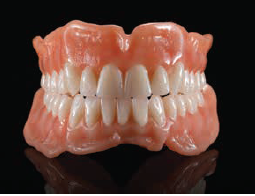
![]()
Ivoclar Vivadent developed a system for simplifying the process of removables that works for dentists who are just starting out, as well as for doctors who have been struggling with removables for years. I’m teaching this system during the course. A systematic approach leads to favorable outcomes. We’re not trying to reinvent the wheel—we’re just trying to grease the wheel a little bit. Dentists don’t have to be frustrated doing dentures anymore.
AD: WHAT KIND OF OUTCOMES CAN PATIENTS EXPECT WITH TODAY’S REMOVABLES?
Dr. Britton: When a patient loses his or her teeth, it’s a traumatic, life-changing event. If dentists can help patients feel more confident about themselves, it’s a huge accomplishment.
The goal is for a denture to not to look like a denture, and to feel more natural. With today’s removables, the teeth can be shaped specifically for the patient’s face (see photo, above). In the old days, dentures were straight, simple, and flat. Now there are many different shapes and shades available. The patient’s age, gender, and facial type all make a difference. If the tooth is properly shaped to the patient’s face, it looks good—it isn’t obvious that the patient is wearing a denture.
AD: IN GENERAL, HOW MUCH BUSINESS DO YOU THINK REMOVABLES CAN BRING TO A DENTAL PRACTICE?
Dr. Britton: Probably a quarter of the patients in my practice need some sort of removable. I’ve been following the protocol that we teach in the course for about two years, and I’ve done hundreds of dentures in that time.
In the past two years, the aggravation associated with denture cases has gone way down because I’ve been using the simplified structure. I used to hate seeing a denture on my schedule because I knew I’d have adjustment after adjustment. Now, it’s a piece of cake. Removables are enjoyable because in the end, patients really like their smile—it looks good and improves function. For patients to go from no teeth to a good-fitting denture is a huge improvement.
For example, a 41-year-old patient that we fitted in a recent course had been wearing dentures for two years, and he had never felt comfortable. His previous dentist extracted his teeth, put in the dentures, and that was it. The patient never went back to the dentist, so he was not aware that the dentures could be any better.
The patient figured he was stuck with the denture the way it was, because everybody he had talked to about it told him that dentures were awful. He didn’t know any different. After being refitted for a denture as a volunteer patient in our course, the comfortable fit made all the difference to him.
Another denture patient told me that he hadn’t had a hamburger for two years until we fabricated a properly-fitting denture for him. After that, he was thrilled to be able to eat a hamburger! It’s the simple things that are important to patients.
AD: WHAT IS DIFFERENT ABOUT THE PROCESS IN THE COURSE THAT YOU TEACH?
Dr. Britton: With the structure that we teach, it’s only a four-step process to delivery. The structure helps dentists communicate with the dental laboratory so that they do not have to have major adjustments from start to finish. In only four steps (four appointments), dentists can be done with a denture patient. It saves valuable chair time, so the dental treatment can be profitable.
Keep in mind that in today’s world, dentures are not just for grandparents anymore. In my practice, we see younger patients who don’t have teeth because of drug abuse, energy drinks, diet sodas, and many other factors. There are acids in many foods that cause tooth decay, and with that tooth decay, patients get tooth loss.
Not everybody can afford to get implants. Dentures are a good alternative. Patients usually don’t know what to expect with dentures because they’ve often heard horror stories. But things evolve. Now the teeth are better, materials are better, and the laboratory processes are better. Everything that we do now is better than what we did before.
AD: WHAT EXACTLY HAS BEEN SIMPLIFIED IN THE NEW PROCESS?
Dr. Britton: Well, pilots don’t take off in an airplane and then decide where they’re going. They have to follow a flight plan. Similarly, the most important thing when planning a removables case is knowing where to start and where you want to finish.
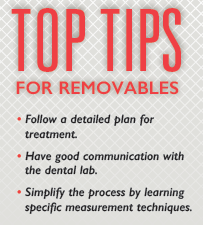
1. First and foremost, dentists need a plan. Don’t just do removable treatments arbitrarily, with no information. Dentists should follow a structure, get the verticals correct, and get the teeth positioned properly.
2. Second, it’s important to have good communication with the dental lab. When dentists don’t provide the lab with proper and accurate information, denture cases become unnecessarily complicated. If the dental lab technician can’t “see” the patient through good impressions, a good bite, and good photographs, then the lab has to use guidelines. Giving accurate
information to the lab technician reduces aggravation between doctor and lab as well as doctor and patient.
3. Third, simplify the process into fewer appointments. In the course, we teach specific techniques to help dentists get accurate information quickly. Taking good impressions is not just luck—there are techniques that can improve a dentist’s skills.
A major part of this process is learning how to correctly take a patient’s vertical. Think about it: if somebody comes in with no teeth, where do dentists set their teeth? The vertical measurement comes from biting the teeth together, so without teeth, a patient has no vertical.

![]()
![]()
Most dentists send an upper and a lower impression to the lab, and the lab arbitrarily uses an average value between the two. But that number is not going to be exactly right. In about eight out of ten of those cases, doctors are going to have adjustments and resets—which complicates matters for the patient, the doctor, and the lab.
AD: WHAT ARE SOME TIPS ON TAKING THE PROPER VERTICAL?
Dr. Britton: One thing that is unique to the course is the process of using the inner and outer canthus to find the proper measurement. That measurement correlates with the patient’s vertical. Also, the interalar width of the nose determines the size of the tooth to use. Dentists have to start somewhere, and these tips and tricks get the ball rolling.
Participants in the course receive a Smile Design Kit which includes tools for them to use, so they leave the course with not only academic knowledge, but with physical tools to help make the process easier.
One tool that can cut the time in half is the papillameter, which is used to measure the smile line. Instead of using bite blocks and wax rims, we use esthetic control bases (ECBs). Everything should be worked out in the ECB, and after that, it might require minimal adjustment. Again, if dentists know where they’re starting and where they’re going, the outcome will be favorable.
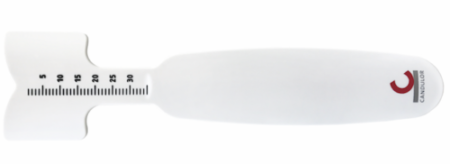
![]()
![]()
Other tools can help dentists get the right fit without requiring dozens of readjustments. For example, if a patient comes in with an ill-fitting denture that they’ve been wearing for several years, there is still valuable information in that old denture we can use.
Instead of simply taking upper and lower impressions and sending that to the lab, use those tools. Use the denture gauge to get the vertical, take photographs, use the papillameter, and use the alameter. There are many different tools that dentists can use to provide the laboratory with the detailed information needed to make the ECBs—all of which will make the denture process easier.
AD: WHAT ARE SOME OF THE MOST COMMON ISSUES THAT DENTURE PATIENTS COMPLAIN ABOUT?
Dr. Britton: The most common issues patients complain about with dentures are fit, function, and phonetics. The setting of the teeth dictates their phonetic speech, so if dentures are not done properly, they can really affect speech. If dentists don’t get the size or length of protrusion correct, the patient is going to have difficulty speaking.
To avoid common issues, dentists have to start out right. Many doctors will place the dentures and think they look good. The patient goes along with it because it looks better than what they had—anything looks better than nothing. But as the patient tries to function with it, he or she constantly needs adjustments.
If dentists take improper impressions, the patient is going to have sore spots. If the dentist doesn’t know the patient’s anatomy and where to extend the borders of the dentures, they’re going to get sore spots. With sore spots, patients return again and again for adjustments, or they simply are noncompliant with the denture.
AD: WHAT CAN BE DONE ABOUT SOME OF THOSE COMMON ISSUES?
Dr. Britton: Assuming that the proper measurements were taken and the dentures fit well, if dentures are well taken care of, they can go years without being readjusted or relined. The only maintenance required is cleaning.
But if teeth don’t have proper fit or function at the start, it’s like having a gear in a machine that’s off. The gear is going to wear down. The teeth will wear down if the occlusion is not set up properly at the outset.
It’s tough to get used to something in your mouth that’s not supposed to be there. Patients have to figure out how to wear it first. But if dentures are not set up properly and patients struggle from the start, the chances of them wanting to continue and figure out how to wear them are diminished.
AD: WHAT DO YOU WANT OTHER DENTISTS TO LEARN ABOUT REMOVABLES?
Dr. Britton: I challenge doctors to look at removables differently. This is not a “set it and forget it” endeavor. It is a customized process—matching the outcome to the morphology of each patient’s face, and making him or her look and feel like they have as close to their real teeth as possible.
In addition, dentures can be a stepping stone to higher levels of dentistry when the patient’s circumstances change. Dentists will learn to deliver a level of dentistry for edentulous patients that can differentiate their practice. In the mass of dentists who give poor-fitting, run-of-the-mill dentures, why not be the dentist who can make patients feel like they are as close to having their natural dentition as possible? Today’s materials and technology make it all possible.

